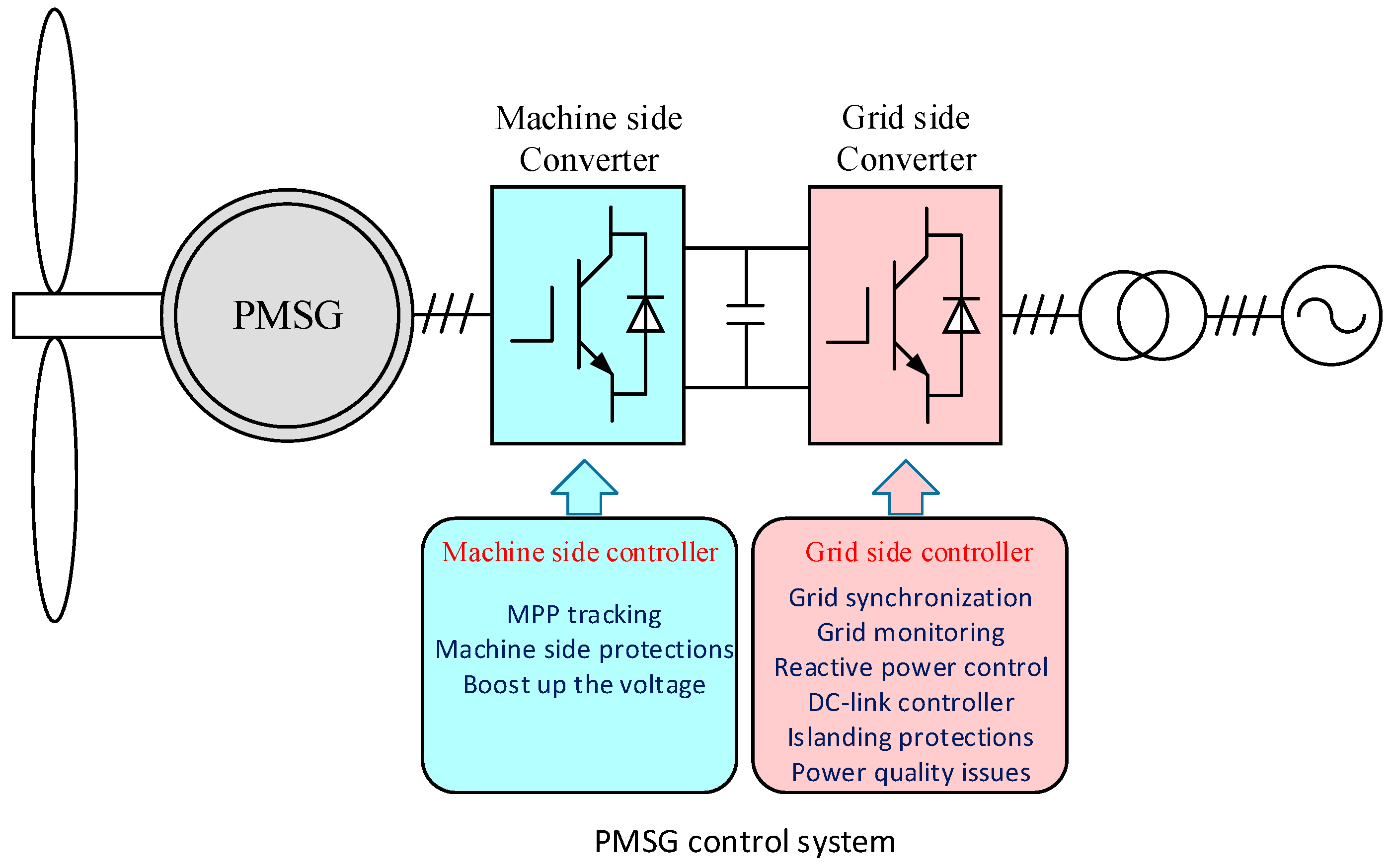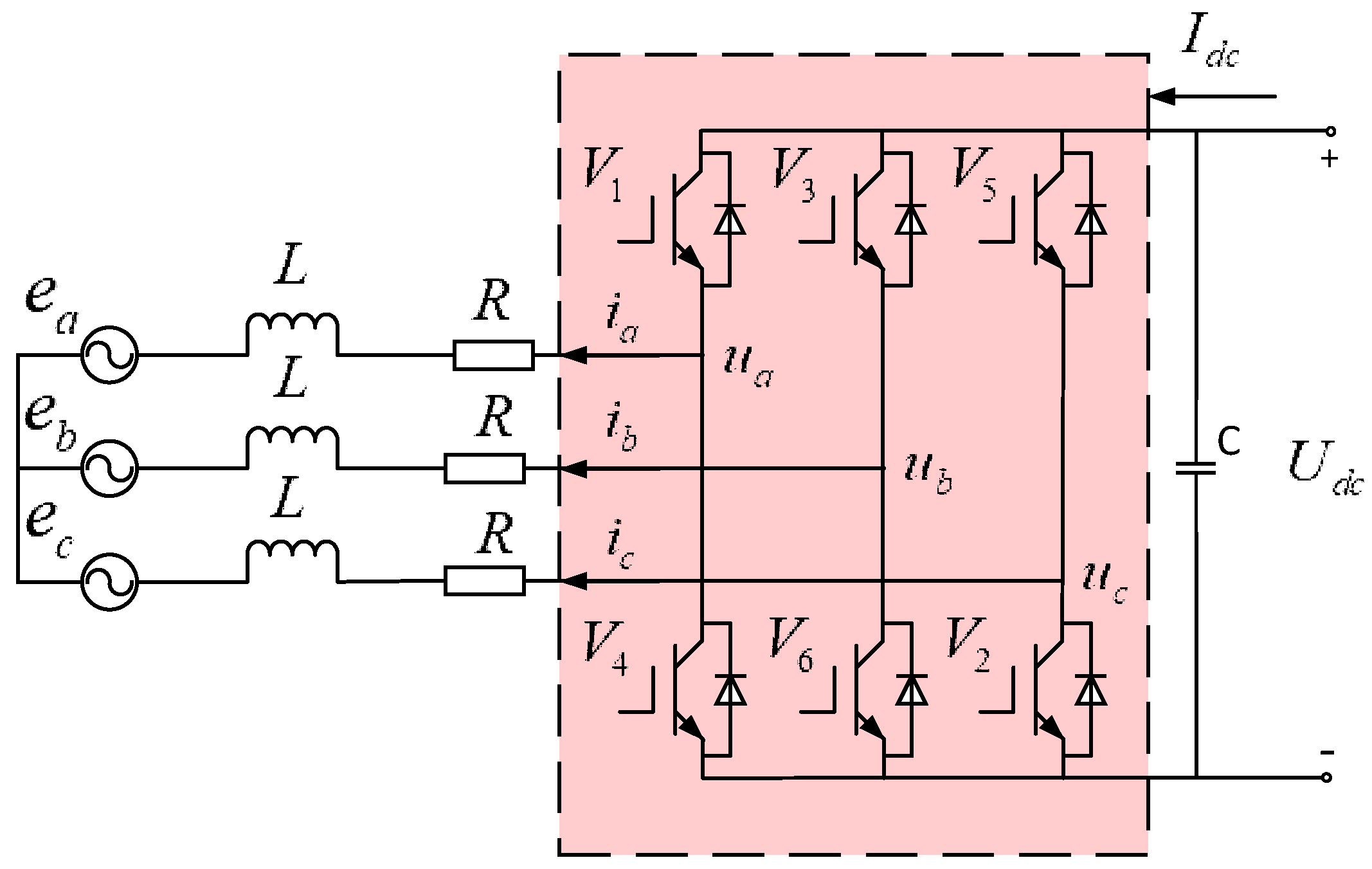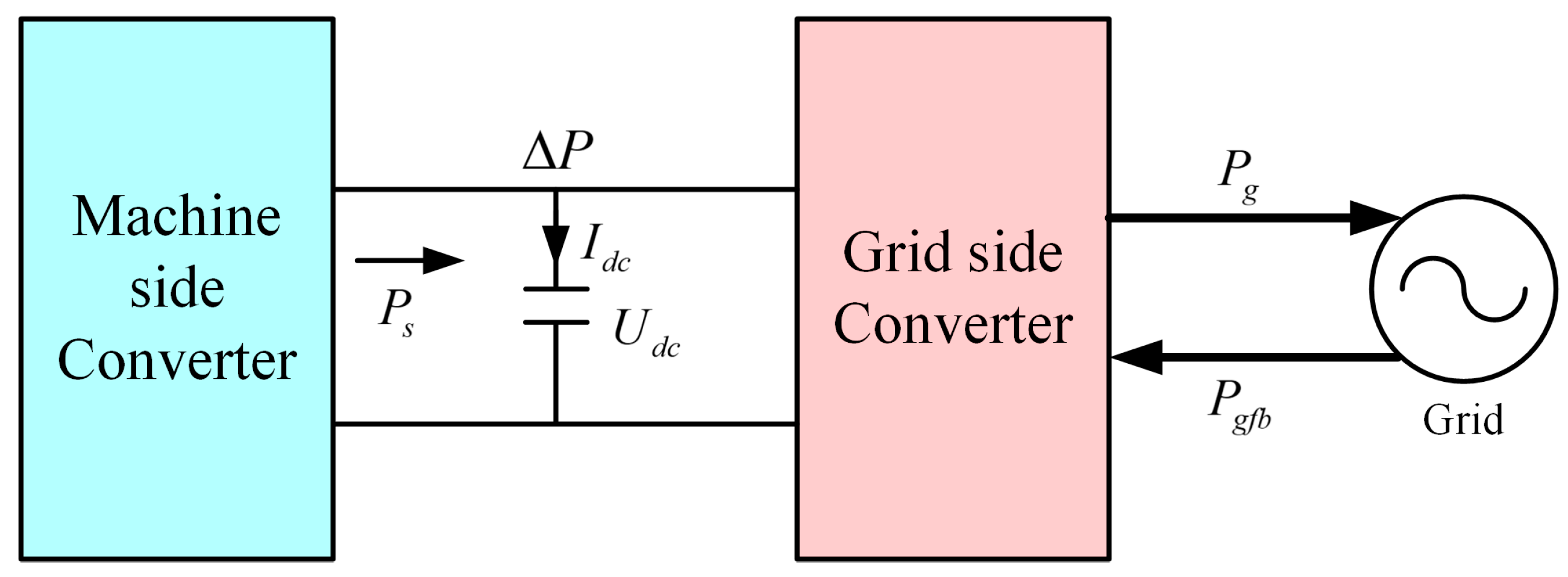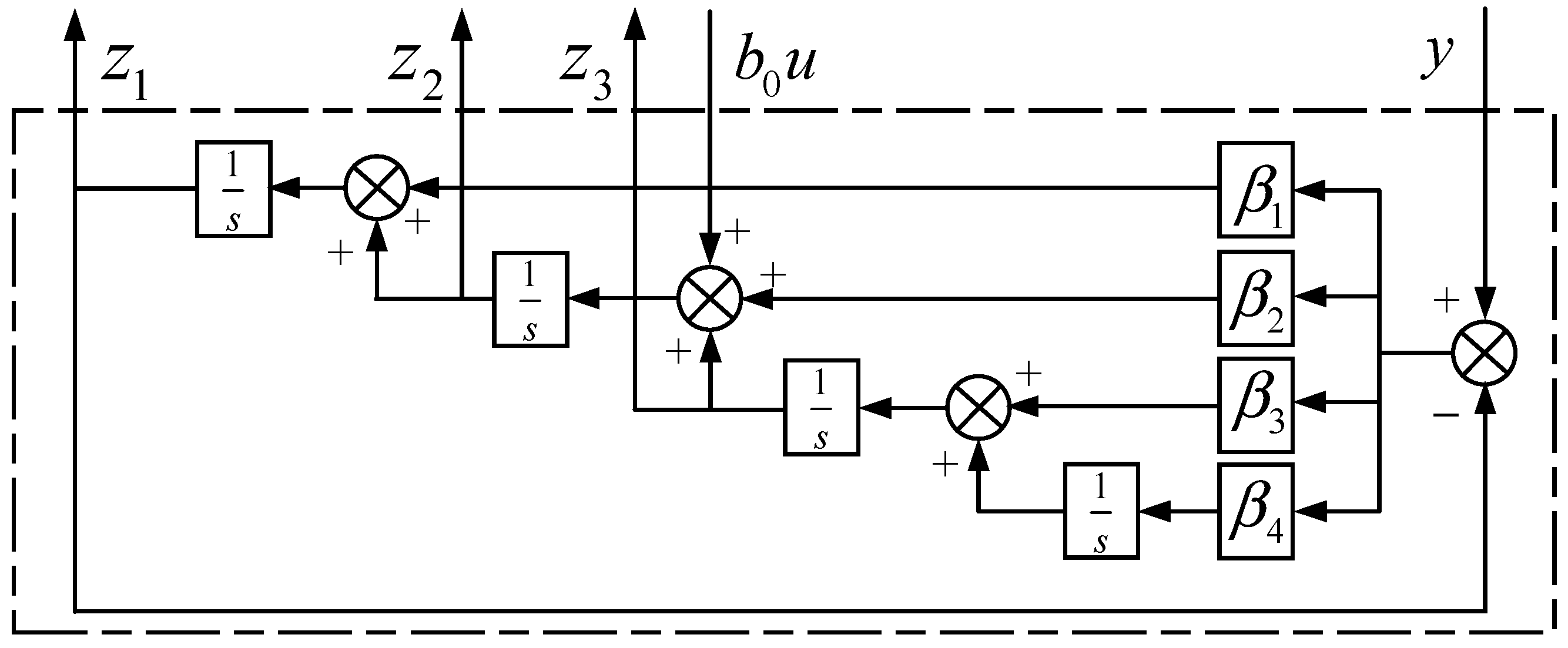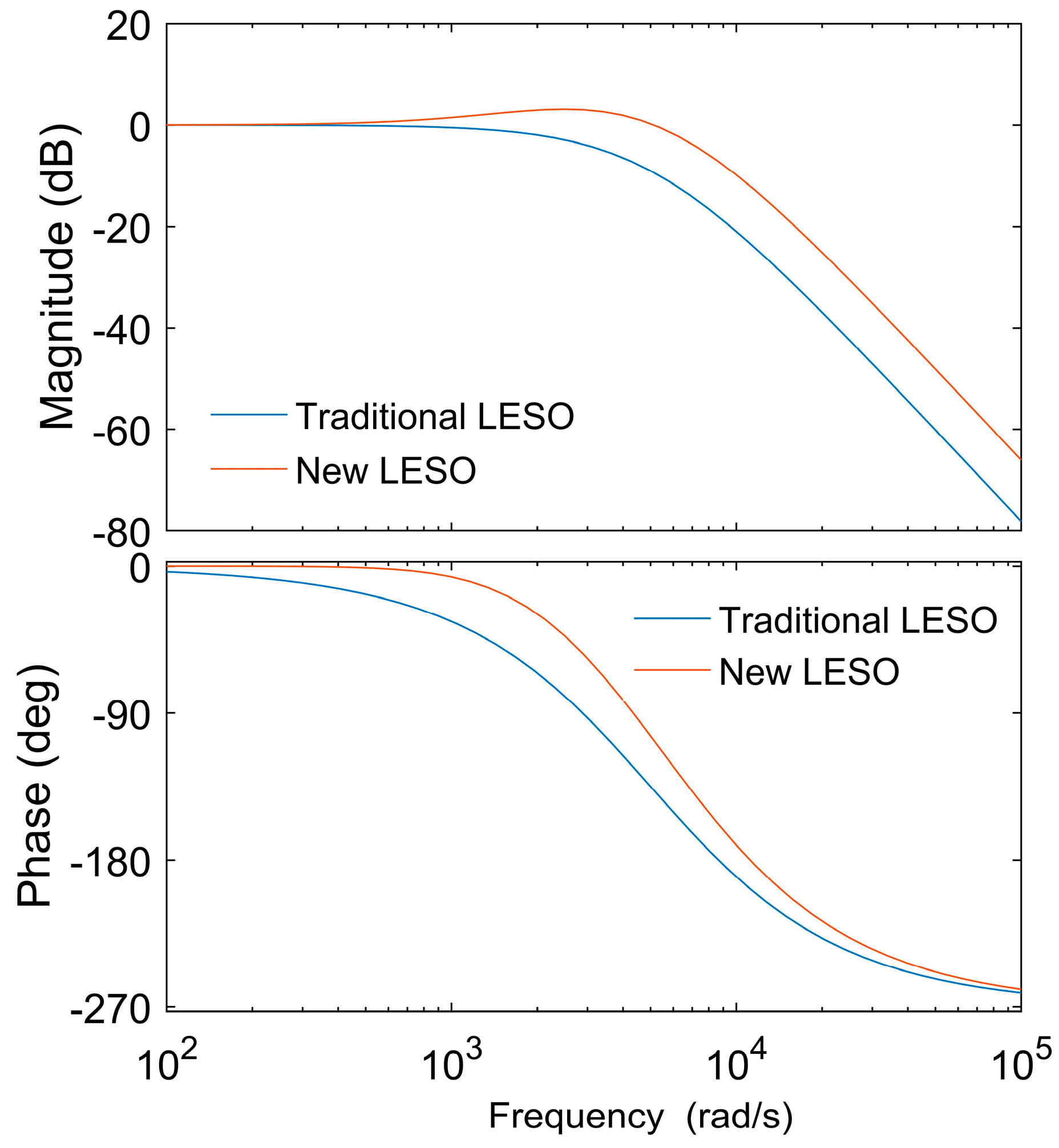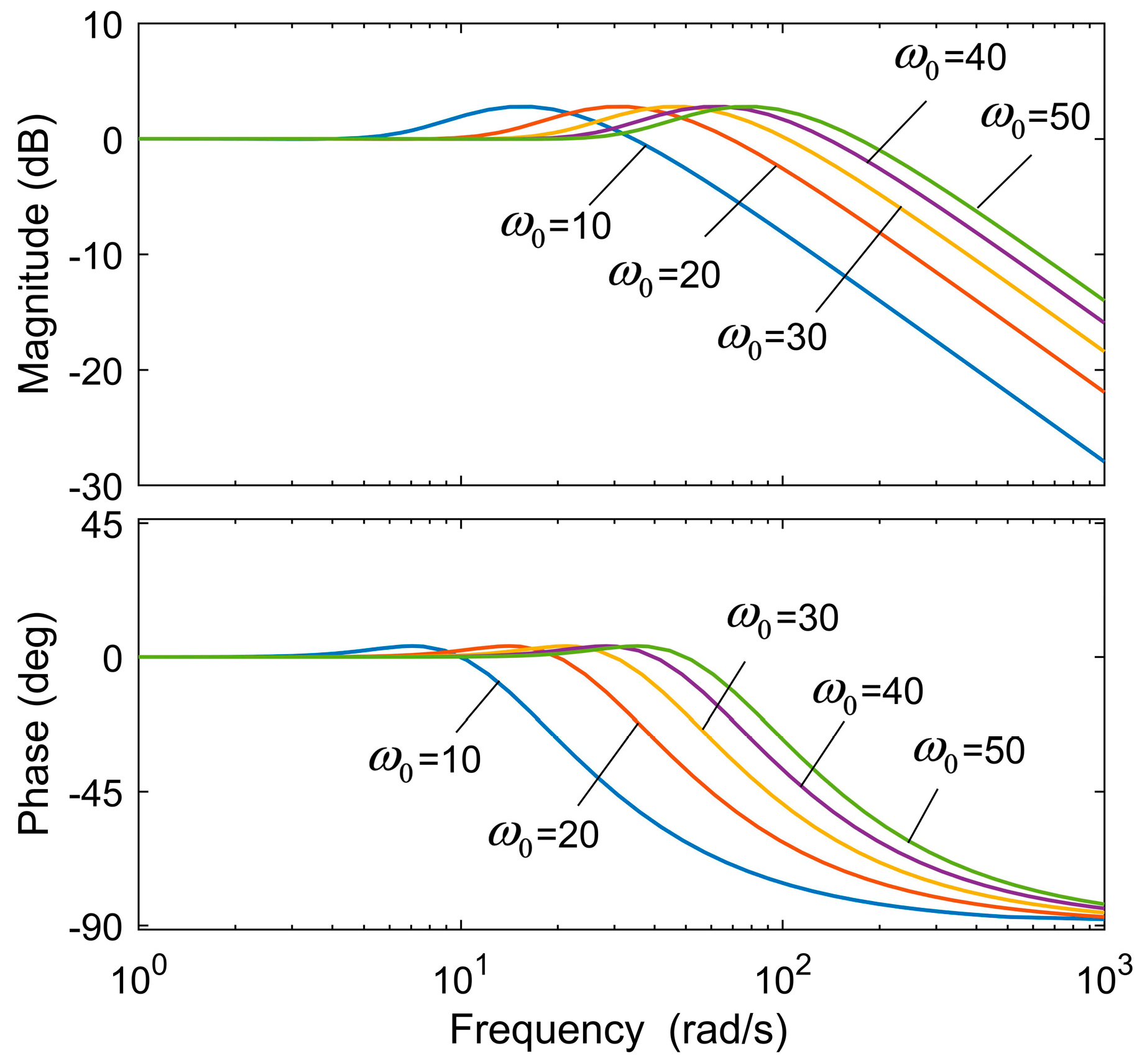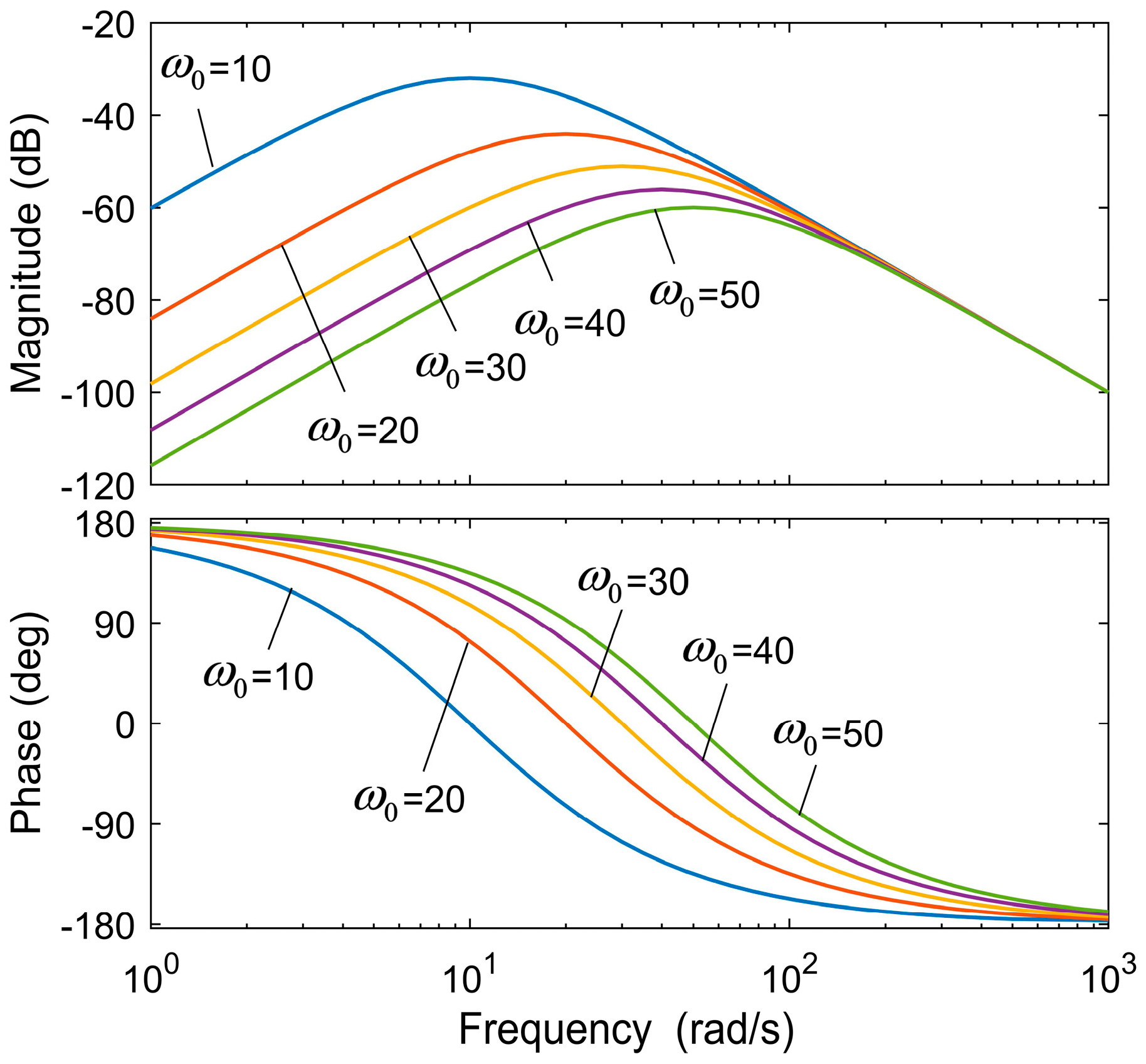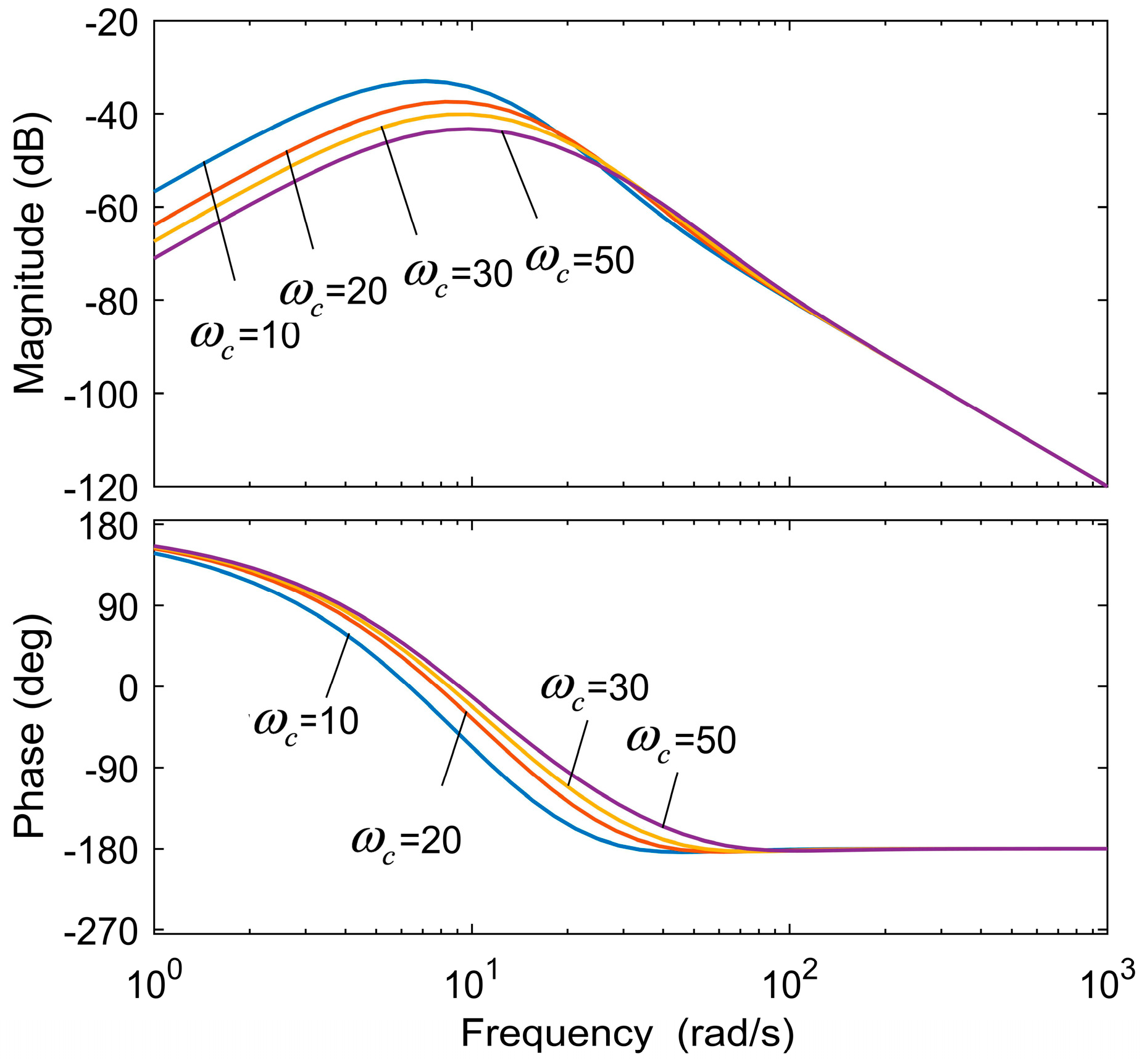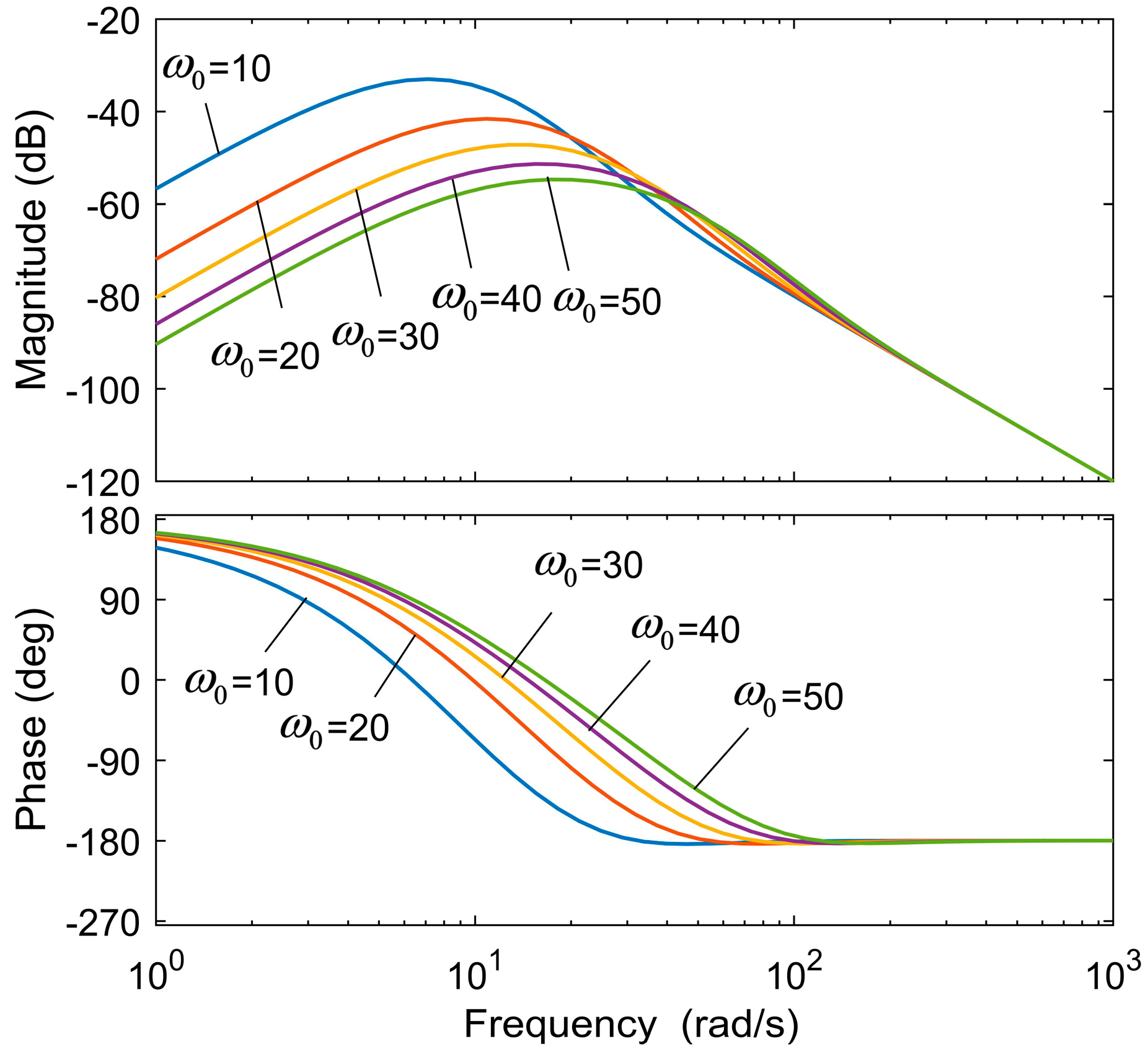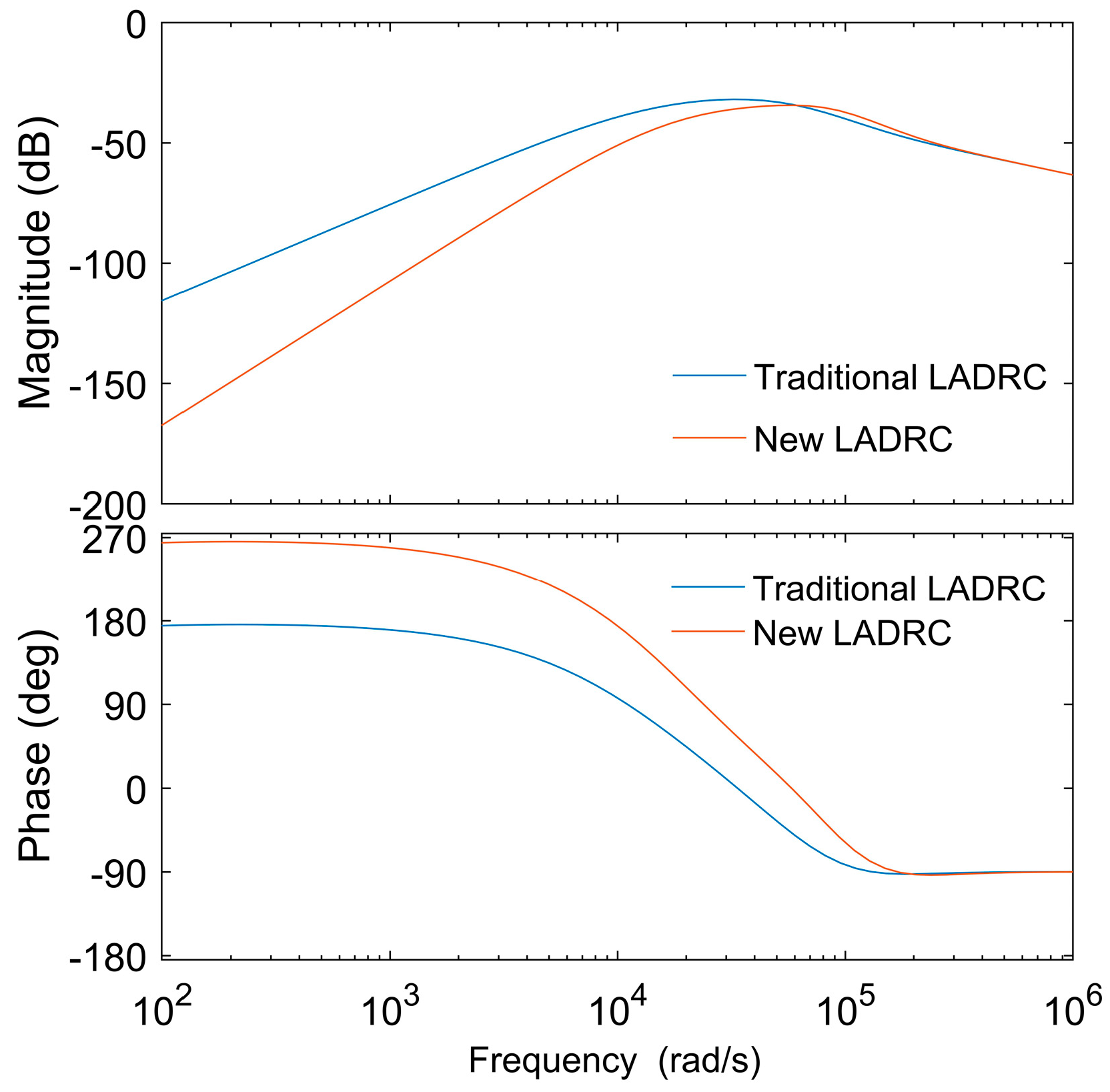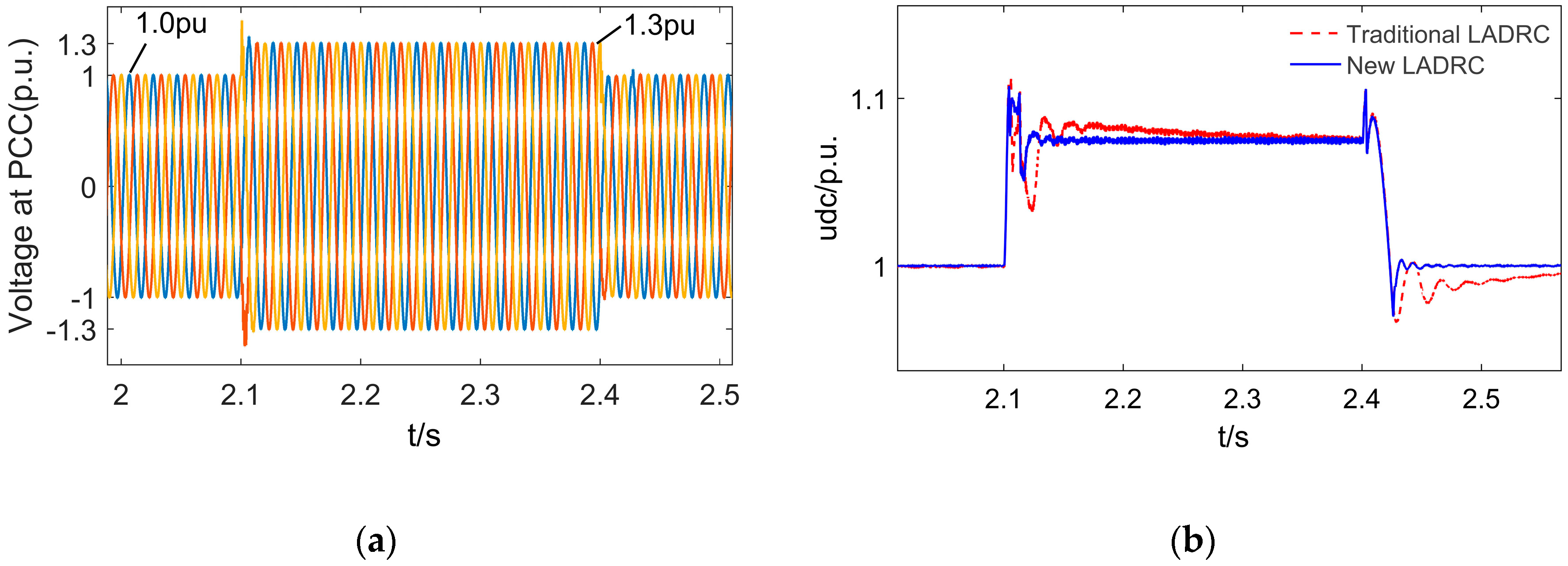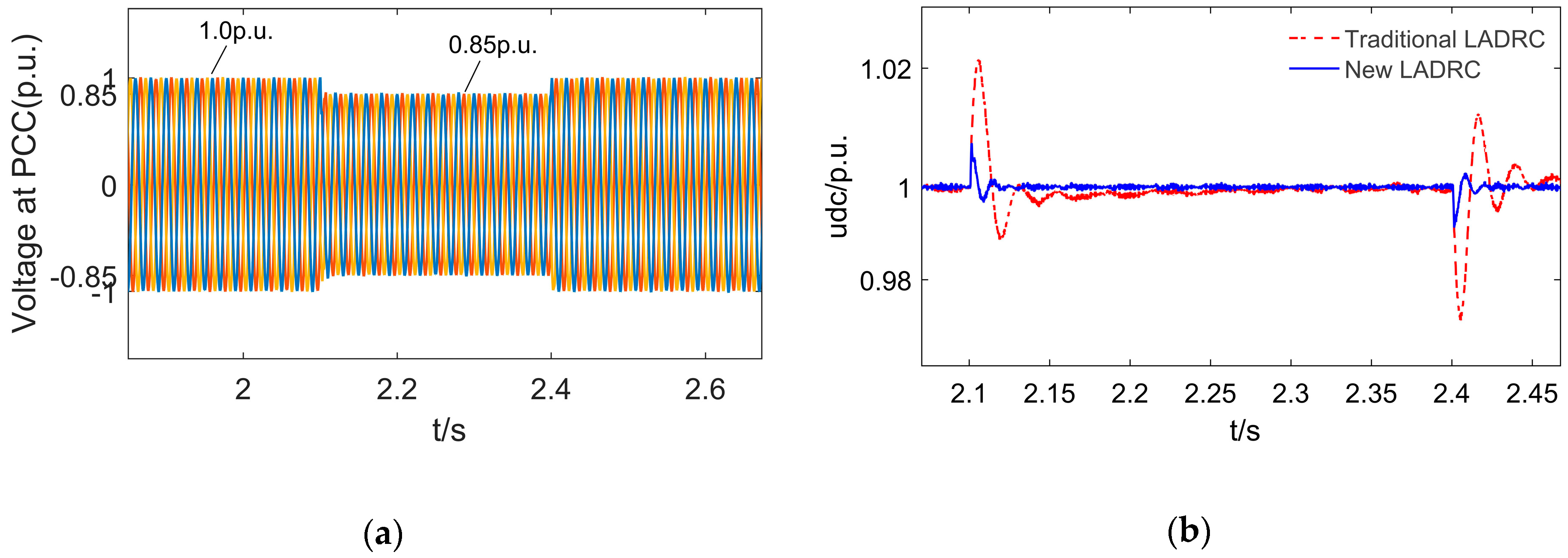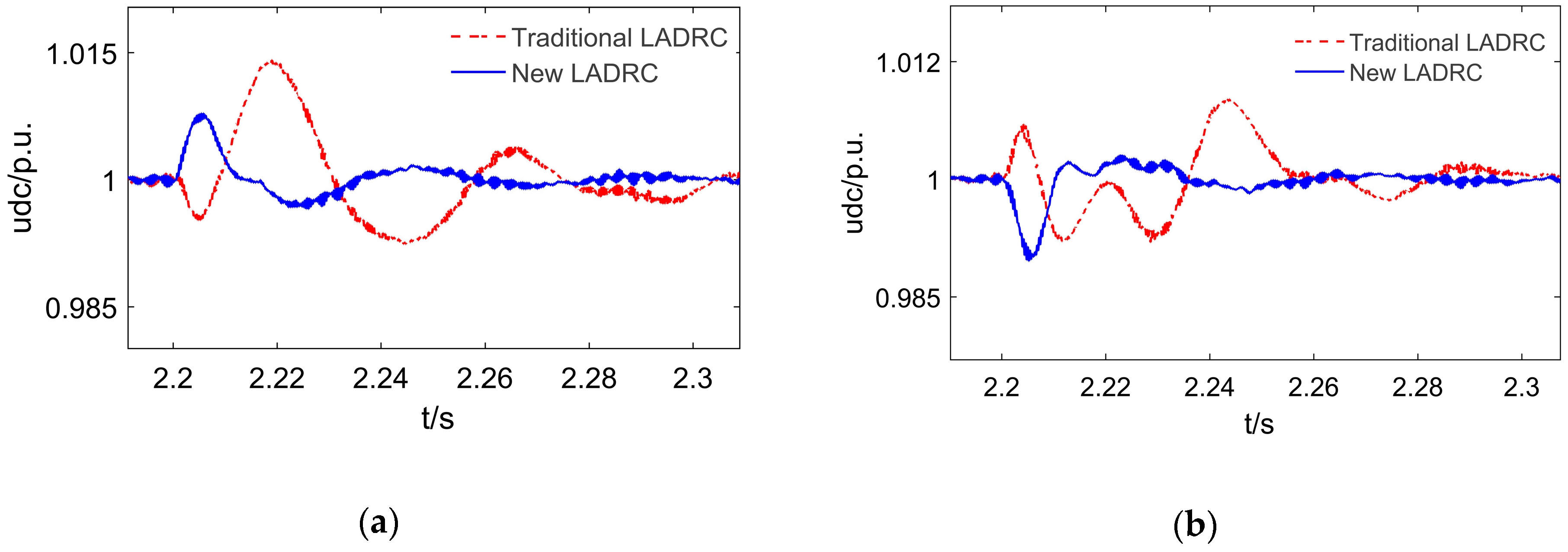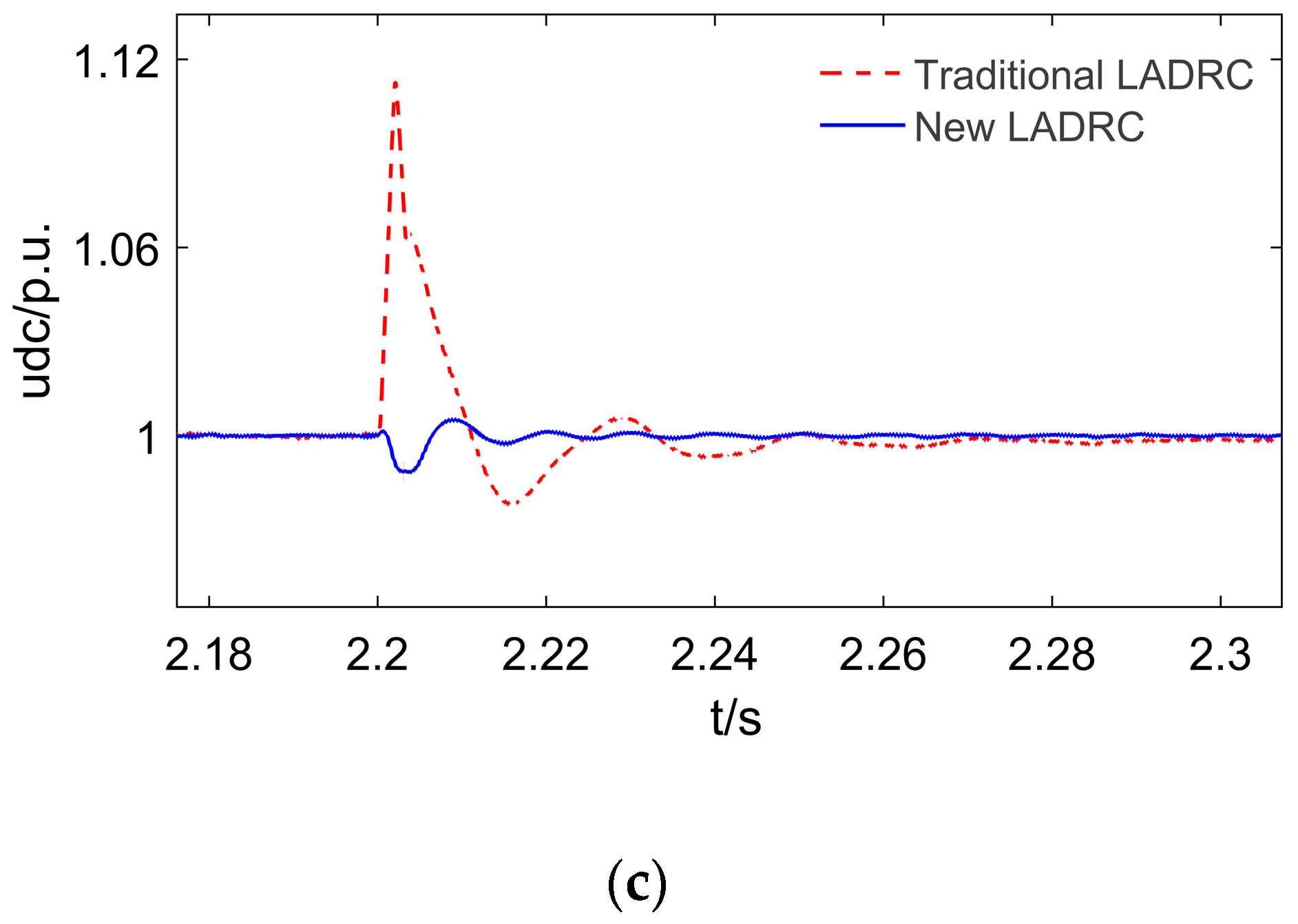1. Introduction
As the environment deteriorates, protecting the environment, conserving resources, and reducing pollution emissions have become the consensus of mankind. At present, most thermal power plants still use non-renewable fuels such as coal, oil and natural gas, and the pollutants they produce are the main source of air pollution [
1,
2,
3]. Therefore, reducing pollution emissions and reducing fuel costs have become research hotspots. At the same time, with the rapid development of clean energy represented by wind power, its grid connection will greatly alleviate the negative impact of traditional power generation systems on the environment. Grid-connected inverters are power electronic converters to realize Direct Current (DC) Alternating Current (AC) conversion and are the core devices connecting wind turbines and power grids [
4,
5]. They are widely used in a variety of industrial equipment, such as wind power generation, photovoltaic power generation and the frequency conversion speed regulation system [
6,
7,
8]. With the popularization of wind power generation, the interaction between the power grid and wind power system has become increasingly prominent. Firstly, the wind power generation system realizes power conversion and the grid-connected operation through the grid-connected converter. The dead-time, conduction voltage drop and non-linear load of switching devices in grid-connected inverters will affect the power quality of feed-in power grid [
9,
10,
11]. Secondly, the output active power and output current of the wind power system will be affected by unbalanced negative sequence components and harmonics in the power grid [
12,
13]. When harmonic resonance occurs between power generation system and power grid and multi-inverters are coupled with each other, harmonic interaction will occur, which is not conducive to system stability. Therefore, it is necessary to improve the performance of the control algorithm, eliminate its disturbance to the power grid, and ensure the safe operation of the wind power grid-connected converters under over-voltage, low-voltage and machine side disturbances, which is of great significance to the efficient and stable operation of wind power generation system. In the output power of grid-connected inverters, there is a pulsating power component [
14], which is twice the power frequency. The instantaneous power mismatch between the input and output of the inverters occurs. To suppress the influence of low-order harmonics, a large capacity electrolytic capacitor can be connected in parallel to the DC bus of the inverters to realize power matching decoupling [
15].
For the control of the DC side bus voltage, the first problem is the modeling. The full power converter is a strong nonlinear time-varying system, which is difficult to model directly by classical linear analysis methods such as Laplace transform. The commonly used state space averaging rule ignores the high order term in the power converter model, resulting in low accuracy of the small signal model, which affects the control performance. In order to improve the system’s rapidity, robustness and adaptability, the choice of control methods is critical. At present, the more mature classical Proportion Integration Differentiation (PID) control strategy is widely used because of its simple and understandable controller design, no need for accurate system model, simple parameter tuning and other advantages [
16,
17]. However, the control strategy of eliminating errors based on error feedback has limited effect on solving the contradiction between system rapidity and overshoot.
At present, the harmonic suppression of inverters mainly includes the methods based on interference compensation [
18] and internal model principle [
19]. Based on internal model theory, such as resonant controller [
20] and repetitive controller [
21], both of them can achieve no static error control of periodic signals. To achieve the effect of suppressing more specific order harmonics, resonant control needs more resonant links, while repetitive control has some shortcomings such as poor dynamic performance. Interference compensation is to observe the summation disturbance of the controlled object and compensate by the disturbance compensation link, which can improve the immunity and robustness of the system. The active disturbance rejection controller (ADRC) proposed by Han provides a new idea for disturbance compensation method [
22]. The core element of ADRC is extended state observer (ESO), which observes the actual motion of the system through input and output of the system. A new state variable is proposed innovatively. Its physical meaning is the sum of internal and external disturbances of the system. ESO observes the system in real time and compensates the control system to integrator series through disturbance compensation link [
23]. Therefore, ADRC does not depend on the system model and is suitable for highly non-linear uncertain systems with high control accuracy and robustness. ADRC technology makes up for the lag phenomenon in traditional PID control strategy. It can show its superior control effect in high precision control and obvious external disturbance situations. According to [
24], it simplifies the structure of nonlinear ADRC. A linear active disturbance rejection control (LADRC) is proposed. The ADRC parameters are simplified to the bandwidth of the controller and the observer by using pole assignment method, and its disturbance rejection and stability can be studied in frequency domain.
At present, ADRC has made great progress in many fields, such as precision control, motor speed control system, etc. It has become a strong competitor of traditional PID control methods. At the same time, ADRC is less used in grid-connected inverters. According to [
25], nonlinear ADRC has been used in inverters, but the controller design is complex and has many parameters. According to [
26], the observation bandwidth of linear extended state observer (LESO) is increased by introducing the differential term of output voltage error, but the LESO parameters are doubled after modification, which makes it difficult to tune. In [
27], an adaptive variable gain LESO is proposed, which helps to improve the observation accuracy of LESO and overcome the “peaking” phenomenon caused by the initial state error under constant high gains. According to [
28], a nonlinear/linear ESO switching strategy is proposed, which combines the advantages of high nonlinear ESO tracking accuracy, fast response speed, easy setting of LESO parameters, and insensitivity to disturbance amplitude variation, but increases the complexity of the control strategy.
In this paper, the DC bus voltage of wind power grid-connected inverters is taken as the control object. Firstly, the modeling process of wind power inverters and the basic structure of the traditional LADRC controller are introduced. Secondly, the differential signal of total disturbance is added to LESO to increase its observation bandwidth. By reasonably configuring poles without adding adjustable parameters, it is beneficial to parameter tuning in engineering. Thirdly, the dynamic performance and immunity of the system under the control of new LADRC and traditional LADRC are compared and analyzed, and the stability conditions of the system are given by algebraic criterion. Finally, the control performance of the new LADRC is verified by MATLAB/Simulink (Version R2016b, MathWorks, Natick, MA, USA) digital simulation.
3. The Design of the New LESO
In [
24], in order to speed up the tracking speed of LESO, the observer bandwidth should be increased. Meanwhile, the error observation and filtering performance of the third-order LESO are demonstrated from both time domain and frequency domain, mainly focusing on stability and anti-interference performance. However, without analyzing its rapidity, it can be called the dynamic observation performance of LESO. The tracking effect of the total disturbance directly affects the transient effect of the system output, which is analyzed below.
In this chapter, a fourth-order LESO is proposed to enhance the dynamic observability of the total disturbance of the system. Compared with traditional LESO, the new state variable is the differential of the total disturbance of the system. By observing the change trend of the total disturbance, an effective early correction signal can be generated, which can effectively increase the bandwidth of LESO and enhance its dynamics observation capability.
3.1. Modeling of the New LESO
The fourth-order LESO is established as follows:
where
are the observer gains, respectively; the reasonable selection of the observer gains can achieve effective observation of the motion state of the system,
.
The fourth-order LESO proposed in this paper is different from the traditional fourth-order LESO. The structure diagram of new LESO can be obtained from Equation (16), as shown in
Figure 6.
The traditional fourth-order LESO [
30,
34] has two inputs
,
and four outputs
,
,
,
, where
is the second derivative of the output of the controlled system, and
is the observed total disturbance signal. Different from the traditional fourth-order LESO, the new fourth-order LESO proposed in this paper has two inputs
,
, and three outputs
. When the system is in steady state,
is approximately zero. The physical meaning of the new state variable
is that LESO observes the differential signal of the total disturbance, and the mathematical meaning is the derivative of
. Therefore, unlike the traditional fourth-order LESO, the control variable
is placed in the second-order equation (
) instead of the third-order equation (
). Equation (19) can also be seen as an improved third-order LESO.
Based on Equation (16),
can be represented as:
Based on Equation (10), the total disturbance can be expressed as:
According to Equations (17) and (18), the perturbation observation transfer function of the new LESO can be deduced as:
According to the pole configuration method [
33], the new LESO is configured as follows:
Substituting Equation (20) into Equation (16), the transfer function of the new LESO will be:
The transfer function of
and perturbation observations in the traditional third-order LESO is given in
Appendix A. The frequency characteristics of the traditional LESO are similar in the mid-band to the typical second-order system. The phase lag and amplitude attenuation are severe in the frequency domain. There are contradictions between the fast and overshoot in the time domain. These characteristics determine that the performance of the traditional LESO is not ideal.
It can be found that the fourth-order LESO transfer function mainly adds a pair of variable zero-poles, and the reasonable selection of parameters can increase the bandwidth of the fourth-order LESO, thus improving its disturbance observation ability. The poles are allocated to without adding adjustable parameters, thus the engineering setting is less difficult.
The tracking error can be defined as:
,
,
. According to Equations (18) and (21), the tracking error can be reduced to:
Considering the typicality of the analysis, both
and
take a step signal with an amplitude of
,
,
. Then the steady state error can be obtained as:
Equation (23) shows that the new LESO has good convergence and estimation ability, and can realize the unbiased estimation of system state variables and generalized disturbances.
Figure 7 is a comparison of the amplitude and phase curves between the new fourth-order LESO and the traditional third-order LESO. It can be seen that the bandwidth of the new LESO system increases significantly and the phase lag in the intermediate frequency band is alleviated.
3.2. Analysis of New LESO Anti-Disturbance Performance
This section focuses on the effect of the noise
of the observation
and the input disturbance
of the control
on the new LESO. The transfer function of the observed noise
is obtained by equation (16):
where
, respectively, get the frequency domain characteristic curve of this transmission, as shown in
Figure 8. The analysis can be obtained with the increase of
, the following response speed of the system increases, however the high frequency gain increases, resulting in more obvious noise amplification.
The transfer function of the input disturbance
is obtained by equation (16):
where
, respectively, the frequency domain characteristic curve of this transmission has been illustrated in
Figure 9.Compared with
Figure 8, the increase of the observer bandwidth
in
Figure 9 can reduce the phase lag of the system tracking input, but the high-band gain is substantially unchanged, so that the new LESO has a strong inhibition ability on the input disturbance
.
It can be seen from the above analysis that the new LESO with total perturbation differential structure is still effective and robust when subjected to observation disturbance and input disturbance.
4. The Combination of the Actual System with the New LADRC Based on the New LESO
This last section mainly analyzes the introduction of observation total disturbance differential to effectively improve the observation ability of disturbance. The following is the analysis of the actual system immunity performance of the new LADRC based on new LESO.
4.1. The Structure of the New LADRC
According to Equations (12), (13) and (21), the control variable
can be deduced as:
where
According to Equation (18), the model of the controlled object can be expressed as:
From Equations (26) and (28), the system structure diagram can be designed as follows:
In
Figure 5, since the third-order LESO is a multi-input-multi-output (MIMO) module, it is difficult to analyze the frequency domain characteristics of the controlled system through the transfer function. Based on the knowledge of the automatic control principle, the controlled system (
Figure 5) can be simplified to a single closed-loop form according to Equations (12), (13), (21) and (28), as shown in
Figure 10. Therefore, the system characteristics can be analyzed by classical control theory.
According to the system structure diagram, the closed-loop transfer function of the system can be determined as:
The perturbation transfer function is:
Substituting
,
,
into (29), the system output can be expressed as:
According to Equation (31), the system output consists of a tracking term and a disturbance term. When the estimation error of
versus
is ignored, (31) can be simplified to Equation (32).
At this point, the output only contains tracking items, and the system control performance is only determined by , regardless of . The tracking speed is faster as increases. The disturbance term is caused by the dynamic observation error of the LESO and is an important factor affecting the control performance of the system.
According to [
24], it gives the closed-loop transfer function of the traditional LADRC control system. The only difference between the two systems is that the new LADRC enhances the dynamic observation ability of the total disturbance.
4.2. Analysis of New LADRC Anti-disturbance Performance
According to Equation (31), the disturbance term is related to
and
. Where
,
, respectively, and the frequency domain characteristic curve of the disturbance transfer can been illustrated in
Figure 11. Where
,
, respectively, the frequency domain characteristic is illustrated in
Figure 12. It can be seen from the Bode diagram that increasing the
and
can reduce the low-band disturbance gain and the anti-interference performance of the system is enhanced.
When the disturbance is a unit step signal, the output response of the system is obtained from Equation (31):
where
According to the inverse Laplace transform, Equation (33) can be deduced as:
It can be known from (35) that:
Therefore, when the external disturbance is a step signal, the steady-state output of the system is zero. According to Equation (35), increasing the observer bandwidth and the controller bandwidth can rapidly attenuate , and the transition process time is short, indicating that the LADRC with the new LESO has strong anti-disturbance capability.
4.3. Anti-Disturbance Analysis of New LADRC Combining with Practical System
The transfer function of the controlled system can be obtained by combining Equation (29) and
Figure 13:
where
,
and
are the reference values of DC bus voltage, bus voltage and total disturbance of the system, respectively;
represents the transfer function of bus voltage reference input to actual output;
represents the transfer function of total disturbance to actual output, indicating the anti-disturbance performance of grid-connected inverters to maintain the bus voltage stability. The
and
terms describe the transfer function of the filter and bus capacitance, respectively.
According to the Bode diagram of
Figure 14, the new LADRC is superior to the traditional disturbance rejection control in the middle and low frequency bands. In the middle frequency band, the new LADRC has smaller disturbance gain and slightly better disturbance rejection ability than the traditional disturbance rejection control. In the high frequency band, the two curves coincide roughly.
4.4. Stability Analysis of New LADRC
According to Equation (37), the system closed-loop transfer function can be obtained:
where
Since the bandwidth of the controller and the observer are both positive, it can be seen that , .
The stability of wind power inverters can be judged by the stability criterion of Lienard Chipart. The necessary and sufficient condition for stability is that the even order or odd order Hurwitz determinant is positive:
Both the traditional LADRC and the new LADRC system remained stable for a wide range of varying observer bandwidth and controller bandwidth . In fact, changing and only changed the ‘time scale’ of the system and generally did not affect the stability of the system. In the case of offset ±50%, the system still maintained good stability by selecting the appropriate bandwidth.
5. Simulation Analysis
In order to verify the correctness of the mathematical model and the validity of the parameter design, a 1.5 MW direct-drive permanent magnet synchronous generator model was built in Simulink. The control strategy of grid-connected inverters was a double closed-loop structure of DC voltage outer loop and current inner loop based on grid voltage vector orientation. A new linear active disturbance rejection controller based on discrete time is designed. The sampling time of the Simulink system was set to
s. The parameters of the PMSG and controller are given in
Table A1 and
Table A2. The parameters in this paper are obtained by empirical method. Three different faults on the machine side and network side were simulated at appropriate time.
The simulated fault conditions were as follows:
- (i)
The voltage of the grid-connected point rose to 1.3p.u. at t = 2.1 s and was cleared when t = 2.4 s;
- (ii)
The voltage of the grid-connected point dropped to 0.85p.u. at t = 2.1 s and was cleared at t = 2.4 s;
- (iii)
The machine side loading, load shedding, and load failure occurred at t = 2.2 s.
where (i) and (ii) are symmetric faults.
Scenario 1
The symmetrical over-voltage fault was implemented at
s and was cleared at
s, as shown in
Figure 15a.
Figure 15b shows the simulation comparison of bus voltage between the new LADRC control converter and the traditional LADRC control converter when the grid-connected voltage suddenly rose to 1.3 p.u. When the grid voltage rose sharply, the power on the machine side continued to be transferred to the DC bus, and the bus voltage increased rapidly and then stabilized.
The control performance indicators are shown in
Table 1. Voltage fluctuation range, regulation time and voltage stability were selected as important control performance indicators.
Combining with
Table 1 and
Figure 15, it can be seen that the DC bus voltage controlled by traditional ADRC was up to 1.112 p.u. during high voltage traversal period, and the larger impulse voltage may have triggered the protection circuit of hardware. By comparison, the bus voltage fluctuation range and regulation time under the new LADRC control were reduced by 1.9% and 70% respectively, which indicates that the new LADRC had better anti-interference performance.
Scenario 2
The symmetrical low-voltage fault was implemented at
s and was cleared at
s, as shown in
Figure 16a.
Figure 16 shows the dynamic response of the DC side bus voltage when the voltage at the grid point dropped suddenly to 0.85 p.u.
The control performance indicators are shown in
Table 2. Voltage fluctuation range and regulation time were selected as important control performance indicators.
Combining
Table 2 and
Figure 16, it can be seen that the bus voltage fluctuation range and regulation time under the control of the new LADRC were reduced by 1.78% and 80% respectively during the low voltage traversal period, which indicates that the new LADRC has stronger ability to observe the total disturbance under the external disturbance, thus improving the overall anti-disturbance performance of the system.
Scenario 3
The machine side loading, load shedding, and load rejection occurred at t = 2.2 s, as shown in
Figure 17. The control performance comparison is shown in
Table 3. Combining
Table 3 and
Figure 17, it can be seen that the bus voltage under the new LADRC control still has strong anti-disturbance performance, and the regulation time can be reduced by up to 88%, especially under the side unloading condition.
The above working conditions were the simulation results under the standard model. Considering the actual operating state and simulating the simulation under reasonable model, the new LADRC control effect was better than the traditional LADRC. Reasonable model configuration were as follows: Sampling deviation of DC bus was 1% of rated value, bus capacitance was 90% of standard value and filter reactance was 110% of standard value.
It can be seen that the new LADRC voltage outer loop controller based on total disturbance differentiation had strong anti-total sum disturbance capability, including disturbance of machine side power and grid side voltage within the tolerable range. For the traditional LADRC, due to the poor tracking performance of the LESO on the actual total disturbance, the controlled system could be constructed into an integral series through the disturbance compensation link, resulting in an increase in the bus voltage fluctuation range and adjustment time. The introduction of the total disturbance differential term improved the performance of dynamic disturbance observation, and the voltage outer loop control of the new LADRC enhanced the voltage stability of the grid-connected inverter bus.
According to [
35], a first-order nonlinear ADRC was proposed. The experimental results show that the starting surge voltage on the DC-side capacitor can be effectively reduced and the dynamic performance is better, but the controller parameters were more difficult to tune. The bus voltage fluctuated greatly in the steady state, and the fluctuation range was ±7.8%. By comparing the steady-state effects of
Figure 15, the new LADRC proposed in this paper had the advantages of convenient adjustment and good steady-state performance. According to [
36], a second-order non-linear ADRC was proposed. By comparing the bus voltage waveforms during low voltage traversing, it can be seen that the second-order non-linear ADRC had strong control performance, short regulation time and good steady-state performance, but the parameters of the controller were more. The new LADRC proposed in this paper had only three adjustable parameters, which was conducive to practical engineering applications. According to [
37], a control strategy based on first-order LADRC was proposed. The tracking differentiator, extended state observer and state error feedback law were applied to improve the response speed and control precision of the system. In [
37], the fluctuation range and adjustment time of the DC-side capacitor voltage during load shedding were: ±7.1%, 50 ms. By comparing
Figure 17, the new LADRC proposed in this paper had stronger control performance than the first-order LADRC.
6. Conclusions
In this paper, the bus voltage of wind power inverter was taken as the control object. Aiming at the influence of grid voltage fluctuation and machine side disturbance on bus voltage, a bus voltage control method based on improved LADRC was proposed.
Based on the traditional LESO structure, the differential term of the summation disturbance can effectively increase the LESO observation bandwidth and achieve the effect of fast-tracking compensation for total disturbance. The new LADRC voltage outer loop controller based on the total disturbance differential had better anti-interference performance. The simulation comparison between the new LADRC and the traditional LADRC under the conditions of over-voltage, low- voltage and machine side loading, load shedding and load rejection showed that the new LADRC had better control performance for stable bus voltage than traditional LADRC control.
In this paper, the total perturbation differential structure is introduced to increase the bandwidth of the controller. But at the same time, it will amplify the high-frequency noise, which will lead to large-scale high-frequency oscillation of the system control quantity, which is unbearable for the actuator. Therefore, the next research task of our research group is to resolve the contradiction between the performance of the observer and its sensitivity to noise.
